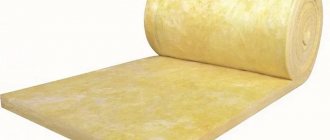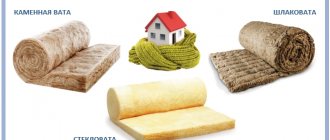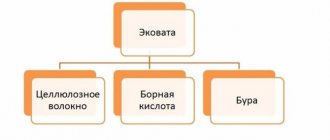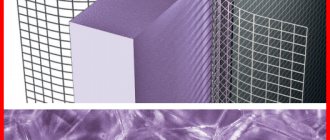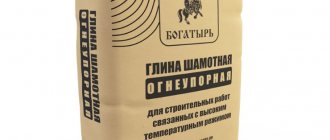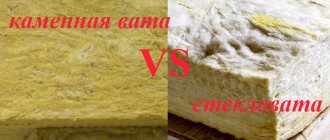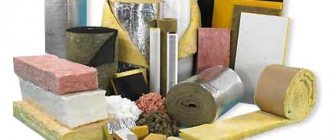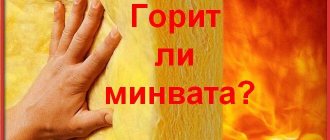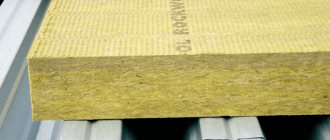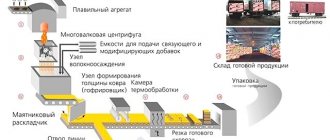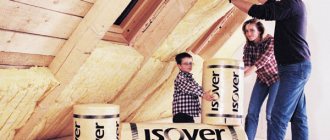Any living space must be properly insulated. Maintaining a comfortable temperature is one of the primary tasks that must be solved when constructing a new facility, or after a period of time during its operation. One of the reliable and high-quality materials that can be used to retain heat indoors is mineral wool.
What is mineral wool?
The definition of mineral wool is enshrined in GOST 31913-2011. According to him, mineral wool is a class of fibrous materials that are obtained from metal slag and molten rocks.
In fact, the concept of mineral wool refers to not one material, but four:
- glass fiber;
- slag;
- stone wool;
- basalt wool.
All four types have a similar mineral wool composition, but differ in the length and thickness of the fiber. Differences in structure determine the properties of the material. You need to understand what kind of mineral wool you need, because the scope of application depends on its basic parameters; different types of mineral wool have different thermal conductivity, moisture resistance, resistance to mechanical loads, and so on.
Mineral wool insulation was used back in Soviet times as a reliable, high-quality and safe insulation material.
Composition of mineral wool (What is mineral wool made of):
Next, we will dwell in more detail on the question: what is mineral wool made of, because mineral wool from different manufacturers can differ in both density and composition:
- The basis of mineral wool is made up of various rocks. Gabbro-basalt and carbonate rocks are a by-product of metal production. They are used as raw materials for the production of glass wool fibers. Rocks make up 90% of mineral wool. The remaining 10% are various additives.
- Various binders are used to tightly bind the fibers. For these purposes, phenol-based resins and bentonite clay are used.
- The material is covered with a thin layer of paper on top. Usually it is kraft paper with polyethylene or aluminum.
We have listed the main components of mineral wool (about 99% of all mineral wool products consist of them). To find out in more detail what type of mineral wool is in front of you: its composition is indicated on the packaging.
Raw materials for the production of insulation
Mineral wool is a fibrous insulation material, the properties and structure of which depend on the source raw materials. Three types of material are used for its production:
- glass;
- blast furnace slag;
- rocks - dolomite, basalt, diabase.
Raw materials for mineral wool production must produce stable fibers during processing and have a low melt temperature. The material is used in its pure form (basalt, diabase) or as part of a mixture. The diameter and length of the fibers depends on the chemical composition of the raw material. Their standard size is 1-10 microns, length from 2-3 mm to 20-30 cm. As the fiber diameter increases, its thermal conductivity increases, so the parameter value is usually limited to 8 microns. Long fibers add softness and elasticity to products.
Mineral wool: varieties
Next, we will tell you what kind of mineral wool there is: in total there are four types of wool - glass wool, slag wool, stone and basalt wool. The last two types have excellent characteristics. The use of the first two types can only be justified by a modest project budget.
Glass wool
This is the most common mineral wool insulation. The fiber thickness of this type of wool is 5-15 micrometers, and the length is up to 5 centimeters. Such characteristics make cotton wool strong and elastic. Care must be taken when working with this material. If the fiber is damaged, glass threads can hurt a person. You should also be careful not to inhale damaged fibers, as fiber particles may enter the lungs. For this reason, when working with this type of mineral wool, builders use special clothing - a respirator, goggles, gloves and a special protective suit.
Technical parameters of glass wool:
| Thermal conductivity coefficient | 0,030 — 0,052 |
| Maximum temperature | 500 degrees Celsius |
| Minimum temperature | -60 degrees Celsius |
| Hygroscopicity of the material | low |
Slag
The fiber thickness of this type of wool is 4-12 micrometers and the length is 1.6 centimeters. This material (like glass wool) has a lot of fatal shortcomings that prevent its use as insulation. It has residual acidity. Because of this, such a material will easily interact with various metal surfaces, oxidizing them. This material easily absorbs moisture. Therefore, it cannot be used for cladding rooms, plastic and metal pipes. It is very prickly, which causes a lot of inconvenience during installation.
Technical parameters of slag:
| Thermal conductivity coefficient | 0,460 — 0,480 |
| Maximum temperature | 300 degrees Celsius |
| Minimum temperature | -50 degrees Celsius |
| Hygroscopicity of the material | high |
Stone wool
What is this type of mineral wool made of: gabbro and diabase, the fiber thickness of this type of wool is 5-12 micrometers, and the length is 1.6 centimeters. This material in its properties resembles slag wool. However, this material does not prick, which will be a big plus during installation. Stone wool does not absorb water well. Therefore, it can be used for heating cladding of premises.
Technical parameters of Stone wool:
| Thermal conductivity coefficient | 0,048 — 0,077 |
| Maximum temperature | 600 degrees Celsius |
| Minimum temperature | -45 degrees Celsius |
| Hygroscopicity of the material | low |
Basalt wool
This type of material is also made from gabbro and diabase. Does not contain blast furnace slag and various additional substances - dolomite, limestone and others. Basalt wool is usually wound into rolls. Mineral wool insulation does not deteriorate during winding. Due to its properties, the material can be used as insulation. This material is very difficult to set on fire. If you bring it to the fire, the fibers will only melt, but the material itself will not burn.
Technical parameters of Basalt wool:
| Thermal conductivity coefficient | 0,035 — 0,042 |
| Maximum temperature | 1000 degrees Celsius |
| Minimum temperature | -190 degrees Celsius |
| Hygroscopicity of the material | very low |
Mineral wool brands
The characteristics of the insulation can be determined by the markings:
- P-75. This is a flexible material with a density of 75 kg/m3. Mineral wool P-75 is usually used for horizontal surfaces that are not planned to be loaded, as well as for structures and communications with a very slight slope. This type of material is suitable for roofing, ceilings, attics, heating and ventilation pipes.
- P-125. The density of this composition is 125 kg/m3. Mineral wool of this type differs from the previous one in that it has improved sound insulation. Also P-125 is more flexible mineral wool. It is considered the best solution if the house is built from gas or foam blocks. P-125 is used for insulating facades, balconies, and interior partitions.
- PZh-175. This mineral wool has the highest rigidity. Thanks to this, it is excellent for loaded as well as vertical structures. The density of PZh-175 is 175 kg/m3. Mineral wool meets the minimum fire safety requirements and provides excellent noise protection. Typically, the material is laid on surfaces made of wood, concrete or steel.
- PPZh-200. This material has the highest density - 200 kg/m3. In addition, PPZh-200 is a non-flammable composition, so it can be used in the construction of retail departments, warehouses and other facilities. However, installation is only possible on flat surfaces, which will only be subject to static loads. This material is not flexible, as it contains an internal reinforcing layer.
Also, when choosing the best material, you should pay attention to its rigidity.
Selection of mineral wool
If you go by the rigidity of the composition, then you should pay attention to the following nuances:
- Soft insulation is best suited for insulating pipes, chimneys, and roofing “pies”.
- Semi-rigid mineral wool is more often used for insulating facades. Also, mineral wool of this type is often placed between sandwich panels.
- Rigid compounds are optimal for flat surfaces made of metal or wood.
The thermal conductivity indicator is selected in accordance with temperature indicators in winter. It is also worth considering the thermal conductivity of the building walls themselves. As a rule, mineral wool is purchased with a small margin of “temperature stability” in order to be prepared for any weather conditions. But you shouldn’t be too zealous either, since in this case the material will cost more.
Also, do not skimp on the manufacturer. It is better to give preference to Ursa, Rockwool, Paroc, and Isover. Germany has the most stringent requirements for insulation materials, which is why their quality is much higher.
Mineral wool: types
Mineral wool is usually sold in the form of solid slabs and mats. The use of mineral wool is for lining walls, ceilings and roofs. Mineral wool allows you to work with non-standard surfaces. Types of wool for insulation differ in density; in accordance with this difference, several brands are distinguished. There is light grade mineral wool, the density of which is up to 75 kilograms, but its scope is small.
Mineral wool grade P-75
Main characteristics:
- Material density - 75 kg per cubic meter. m.
- This soft mineral wool is used to insulate horizontal surfaces with light loads. An example of this type of surface is attics.
- This material is often wrapped around district heating, gas and oil pipes to retain heat.
Mineral wool grade P-125
Main characteristics:
- Material density - 125 kg per cubic meter. m.
- Used for insulation of ceilings, floors, interior walls and partitions.
- The material has good sound insulation.
Mineral wool brand PZh-175
Main characteristics:
- Material density - 175 kg per cubic meter. m.
- The material is very dense and has increased rigidity.
- Used for thermal insulation of reinforced concrete and metal walls and ceilings.
Mineral wool brand PPZh-200
Main characteristics:
- Material density - 200 kg per cubic meter. m.
- The material is very dense and has increased rigidity.
- Thanks to special additives it has high fire resistance.
- This construction mineral wool is usually used for thermal insulation of reinforced concrete and metal walls and ceilings.
Performance characteristics
Since mineral wool is able to cope with increased loads, it is used in the construction of standard structures, as well as when installing insulation followed by the production of a heavy concrete screed (in this case, it is recommended to choose durable slabs 5-20 cm high).
Healthy! The service life of the insulation is 20-30 years.
If we talk about the density of the material, it depends on the shape of the mineral wool:
- the minimum density for light slabs and loose wool is 30-40 kg/m3;
- a little more for soft slabs - 50-75 kg/m3;
- for mats this figure is 50-85 kg/m3;
- semi-rigid slabs – 75-125 kg/m3;
- the highest density of cylinders is 200 kg/m3.
The material is not flammable, but the maximum temperature also depends on the shape of the product. For mats it is +700 degrees, for cylinders, light, soft and semi-rigid slabs this figure is +400 degrees. For rigid slabs +100, and for loose wool the limit reaches +600.
Mineral wool has high density and thermal insulation characteristics. They may differ depending on the specific type of material.
What are the main advantages of mineral wool?
This material is respected by ordinary people and experienced builders. And this is no coincidence:
- High fire resistance. In the production of some types of wool, only non-flammable silicate rock melts are used. This provides the material with a high degree of fire resistance. This type of wool does not burn under the influence of high temperatures, and also does not deform. For this reason, mineral wool is used to line rooms where various flammable substances are stored.
- Chemical resistance. Cotton wool does not react well with various chemicals, which makes it possible to use it for lining laboratories, various workshops, and school chemistry classes.
- Resistance to biological irritants. Neither fungi nor various harmful insects and rodents like mineral wool.
- Minor shrinkage. Many materials shrink over time, losing their original volume. This is especially critical for various joint structures, when reducing the size of one of the blocks can lead to a violation of the tightness of the room. Mineral wool does not have this drawback.
- Extremely low hygroscopicity of some varieties of mineral wool. Hard mineral wool absorbs up to 0.5% of liquid. For this reason, the material does not accumulate water.
- High vapor permeability. Cotton wool allows various water vapors to pass through well. This allows you to quickly remove unpleasant odors from the room. Condensation will not settle on such cotton wool.
- High sound insulation properties. This type of wool can be used to sheathe rooms not only for the purpose of insulation, but also to protect the room from extraneous noise.
- Environmental friendliness. The material is safe for humans and does not cause any allergic reactions.
- Easy to install. Mineral wool was made specifically to facilitate the insulation of rooms. Even an amateur builder can install this material.
- Durability. The service life is about 70 years, so you will not have to change the coating several years after installation.
Features of material selection
Among the numerous manufacturers of mineral wool, the most popular are the following brands: TechnoNIKOL, Ursa, Rockwool, Knauf and Izover. The cost of the material depends directly on its density, because the higher this parameter, the more raw materials are required during production. Although on average the cost ranges from 100-180 rubles per square meter.
Before purchasing, you must carefully examine the packaging in order to find out whether GOST requirements were taken into account during manufacturing. Also read the characteristics, ask the seller to open one package.
Find out where the fibers are directed in the material. If they are vertical, then the mineral wool will perfectly retain thermal energy, but if in a chaotic manner, then the insulation is very durable and, accordingly, can withstand heavy loads. Glass wool and slag wool are cheaper, but you should think twice before purchasing them. Despite the fact that the thermal insulation of these materials is increased, quite a few difficulties arise during their installation. Thus, glass wool, if it gets on the skin or in the eyes, can lead to serious irritation.
What are the main disadvantages of mineral wool?
However, not everything is so smooth. Mineral wool has the following disadvantages:
- If the fibers are damaged, glass wool fragments can hurt a person. Often the damaged fibers are very small. Inhalation of damaged fibers may cause damage to the lungs and airways. This drawback can be solved very simply - buy a protective suit, gloves, goggles and a respirator.
- Mineral wool often contains formaldehyde resin. Under prolonged exposure to high temperatures, it can oxidize to phenol, which is poisonous. Therefore, when installing in not very safe conditions, experienced builders recommend wearing protective clothing and a gas mask.
Also remember that types of mineral wool, such as stone and basalt, do not have these disadvantages.
Production and properties of basalt wool
A little history:
For the first time, thin threads of volcanic rock were discovered in Hawaii. After the volcanic eruption, scientists noticed interesting finds. The hot lava flew up, and the wind pulled the rocks into thin threads, which solidified and turned into lumps similar to modern mineral wool.
Production of basalt insulation
Thanks to heat treatment at fairly high temperatures, rock materials are transformed into fibrous material. After that, binding components are added to them and put under pressure. Next, the fiber enters the polymerization chamber, where it turns into a solid product.
Basalt insulation can have a high density, which gives the product additional rigidity and good load resistance. The porous structure helps absorb impact noise. During the production process, cotton wool of various structures can be obtained. The more flexible one is used in pipelines, the semi-rigid one is used to insulate houses, and the rigid structure is indispensable in production.
Properties of basalt mineral wool:
- soundproofing;
- high thermal insulation;
- safety;
- moisture resistance;
- durability;
- absolutely non-flammable.
Basalt fiber is produced in rolls and slabs. It is very light and easy to cut.
Note!
Recently, the foil type of product has become very popular among builders. Thanks to the foil, an increased level of heat conservation is obtained. It is suitable for insulating any surfaces; this is the material used for ventilation and refrigeration systems.
Mineral wool: scope
Mineral wool is used as a building material. It is also used to insulate walls, pipes and various structures. Sometimes mineral wool is used to create sound insulation, but only basal wool has good noise-reducing properties.
Construction materials: mineral wool
In construction, mineral wool is used mainly as insulation. With its help, they create a special wall covering that does not let cold air into the room, but retains warm air. Usually walls are sheathed from the inside, but sometimes some types of cotton wool are also used for sheathing walls on the outside. Cotton wool is also used to insulate gas-carrying pipes on the streets and in the entrances of houses.
Mineral wool insulation: slabs
There are different types of mineral wool for insulation, but you should give preference to mineral wool slabs. And that's why:
- The slabs are easy and convenient to cut.
- The slabs are easy to transport and do not require special care.
- The slabs can be laid on an uneven surface to hide the imperfections of load-bearing walls.
ISOVER Warm Roof Strong
To insulate walls, choose a specialized product ISOVER Warm Walls Strong with Formostability technology, which guarantees stability in the structureFor the roof, use the material ISOVER Warm Roof Strong with technology AquaProtect, which provides the material increased moisture resistance Mineral wool creates maximum warmth and comfort in a house or apartment. The material is made from natural components: quartz, soda, limestone. Recommended for use even in medical and children's institutions, because mineral wool is a safe material for human health and the environment.- Maintains a comfortable temperature in the house thanks to the low thermal conductivity coefficient
- Does not require additional fasteners during installation due to high elasticity
- Has enhanced moisture resistance
- Easy to use - already cut into slabs for standard frame spacing
- Safe for human health and the environment
- Belongs to the group of non-combustible materials (NG)
- Features enhanced moisture resistance thanks to AquaProtect technology
- Reliably fixed in the frame without creases or slipping due to the high elasticity of the material
- There is a minimum of waste when insulating a roof with different rafter pitches
- It is convenient to cut the roll into the required sizes thanks to special markings on the packaging
- Safe for human health and the environment
- Belongs to the group of non-combustible materials
- Pitched roofs and attics
- Insulation of walls from the inside
- Insulation of walls from the outside: insulation under siding/cladding/cladding bricks
- Frame walls
- Insulation of balconies and loggias
- Pitched roofs and attics
- Insulation of walls from the inside
- Insulation of walls from the outside: insulation under siding/cladding/cladding bricks
| Parameter | ISOVER Warm Walls 50 mm. | ISOVER Warm Walls 100 mm. | ISOVER Warm Roof 50 mm | ISOVER Warm Roof 100 mm | ISOVER Warm Roof 150 mm |
| Mineral wool thickness, mm | 50 | 100 | 50 | 100 | 150 |
| Mineral wool width, mm | 610 | 610 | 1220 | 1220 | 1220 |
| Mineral wool length, mm | 1000 | 1000 | 4100 | 4100 | 4100 |
| Quantity per package, m2 | 6,1 | 3,05 | 10 | 5 | 4,88 |
| Quantity per package, m3 | 0,305 | 0,305 | 0,5 | 0,5 | 0,735 |
| Quantity per package, pcs. | 10 | 5 | 2 | 1 | 1 |
| Thermal conductivity at temperature (10±2)0С, λ10, no more (W/(m•K), GOST R 31924 | 0,034 | 0,034 | 0,034 | 0,034 | 0,034 |
| Flammability group, GOST 30244-94 | NG | NG | NG | NG | NG |
How to safely install mineral wool?
When installing mineral wool, you must follow these rules:
- Wear a protective suit, respirator, special glasses and gloves.
- When working with the material, cover it with polyvinyl chloride film, which allows steam to pass through.
- Give preference to materials from a reliable manufacturer.
- To create mineral wool insulation, slabs can help you.
- Remember that formaldehyde resin does not oxidize at room temperature.
- If you will be working at high ambient temperatures, give preference to basalt wool, which does not release phenol during oxidation.
How to choose good mineral wool?
When choosing mineral wool, use the following tips from experienced builders:
- Give preference to European cotton wool. The reason for this choice is simple - in the European Union there is a fairly strict certification system, under which mineral wool manufacturers cannot release their product to the market without preliminary tests. Yes, German quality is not a myth, but only a simple consequence of pragmatic European laws. Examples of European wool manufacturers are URSA, Rockwool, PAROC, ISOVER and others.
- If you need mineral wool, the slabs will help you. You can buy cotton wool in rolls, but it is more difficult to transport.
- It doesn't really matter when the mineral wool was made, as it usually has a shelf life of at least 50 years.
- The price of wool directly depends on its density. The explanation is simple - it is much more difficult to make a denser material than a less dense one, which greatly affects the final cost of the product.
- Give your preference to stone and basalt wool. Glass wool and slag wool, although they are very cheap, have many disadvantages. This is both low thermal insulation and low noise insulation. During installation, many problems may arise due to damage to the fibers of the material. If a fragment of fiber gets on the skin, it will hurt and itch.
- If mineral wool is too expensive, using used one will solve your problem.
- The direction of the fibers is of great importance. It is not recommended to use material with horizontal fibers (and such material is quite rare). The vertical arrangement of fibers improves the heat and sound insulation characteristics of the product. If the fibers in the wool are randomly located, then it will withstand high loads.
- Be sure to check the box with the material for printing confirming GOST. Also find out from the seller what the mineral wool you want to buy is made from.
- Don't trust sellers. Suppose you need a slab 5 centimeters thick. Go to the seller and tell him that you need a 5-centimeter thick slab. When the seller brings the stove, ask to open the box to personally verify that the stove matches your order. If the seller tries to dissuade you, don't listen to him, you know better.
- To find out what mineral wool is made from, pay attention to the composition indicated on the packaging.
Insulation errors
Often the reason for negative reviews about mineral wool as insulation from builders is installation errors:
- Insufficient amount of insulation. The optimal thickness in most cases is considered to be 10 cm.
- If the insulation was done from the inside (insulation of the walls in the apartment), then there is no need to dwell on this. When choosing between interior and exterior work, you should give preference to the latter.
- You cannot skimp on fasteners, or use inappropriate fasteners where they are inappropriate. It is important to remember that initiative is not always justified and can backfire.
- If the house has a basement, then it is necessary to pay attention to it, otherwise the insulation will not have the desired effect.
- Accuracy in work is necessary. It is worth laying the layer as evenly and densely as possible.
- It is important to pay special attention to preparing the foundation. Do not ignore cleaning the surface from debris and sanding it in case of unevenness. In the worst case, the insulation will simply fall off the wall.
- It is necessary to avoid getting glue into the joints of the boards. In this case, this is where the cold will come in.
- Insulation work must be carried out in warm, dry weather. It is necessary to remember - no moisture.
- When attaching the mesh, one important rule should be taken into account - we use only glue, we keep the putty for other work.
- It is necessary to insulate at least 60% of the surface to achieve the desired result.
